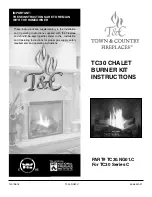
SERVICING
Isolate the fire from the gas supply. Ensure that the fire is fully cold before attempting service. A suggested procedure for servicing is detailed
below.
1. Lay out the dust sheet and tools.
2. Carefully remove the ceramic components.
3. Remove the decorative front and frame.
4. Remove the two screws that retain the data/control plate.
5. Disconnect the gas supply, and remove the two securing screws in the tray legs.
6. Remove the burner tray.
7. Remove convector box as described.
8. Check the fireplace opening for rubble accumulation and remove. If debris is excessive, initiate remedial work on the flue.
9. Check the flue with smoke pellet for correct operation.
10. Refit convector box using new seals where necessary
11. Strip off the burner pipes and clean thoroughly.
12. Clean out the injector, pilot assembly and burner tube. DO NOT remove the pilot injector.
13. Re-assemble and re-fit the burner tray.
14. Turn on the gas supply, and leak test.
15. Refit the decorative firefront and ceramics.
16. Check any purpose provided ventilation is un-obstructed.
17. Light the fire and test for spillage.
18. Check setting pressure and safe operation of the appliance.
For specific servicing instructions, see the relevant sections.
CLEANING THE CERAMICS
Remove the firefront and place to one side. Remove the ceramic components. Gently clean in the open air. Be careful not to create dust
from the coals/pebbles. Where necessary replace damaged components with genuine spares. Seal scrap ceramic components in plastic
bags and dispose at proper refuse sites as directed.
Re-fit the coals/pebbles by referring to the relevant section of these instructions.
REMOVING THE BURNER TRAY
Remove the decorative front and frame. Remove the ceramics and the data/control plate.
Remove the two screws securing the tray legs to the firebox. Pull tray forward slightly and lift away.
Refitting is the reverse of above, being sure to engage the tray location lugs on the shelf at the rear of the firebox.
DISMANTLING THE BURNER TRAY
Remove the tray as previously described. The pilot unit can be removed by undoing the tubing nut, the thermocouple nut on the rear of the
valve, and the two securing screws, and lifting away. Remove the tubing nut from the valve end of the pilot pipe, and blow through to dis-
lodge any debris. Clean the exterior of the pilot assembly with a soft brush and blow through the flame ports on the pilot head. Remove the
lint arrestor, and check the aeration holes are free from lint or dirt. The pilot assembly is a non-serviceable item, and should not be taken apart.
The aeration hole must be absolutely clear internally for proper operation. See specifications for gap setting.
Remove the two tubing nuts on the ends of the gas pipe to the injector elbow. Release the screw through the supporting leg and lift assem-
bly clear. The injector pipe can now be checked for debris. Remove the nut retaining the injector elbow. Blow through the elbow to remove
any debris.
The valve is not field serviceable, apart from the pilot filter. Remove the control knob by pulling it forwards, then remove the largest of the
three screws on the face of the valve. Slide the filter out and clean away any debris that may have accumulated. The filter element should also
be blown clean. This component should not require replacement, however if signs of deterioration are evident then a genuine spare must be
used. If a large amount of debris is present in the filter then the pipework and control should be thoroughly cleaned before re-assembly
.
11
14.0
14.1
14.2
14.3
©
2010 Focal Point Fires plc.











































